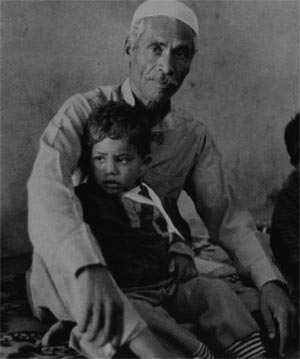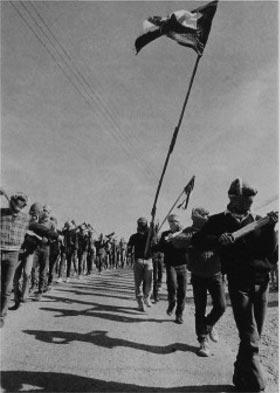by Eleanor J. Bader
One afternoon in October, in the tiny village ofHawwara, off the Nablus Road, American visitors found two she-goats, two kids and five chickens that had been shot by Israeli settlers only moments earlier. The youngest child in the family, about six years old, had thrown a small stone at the settler’s car as it passed the family’s house. In response, the carload of six settlers entered the back of the house and fired 20-30 shots at the sheep and goats.’The next time I’ll come back and kill you and the sheep,’ one of the settlers shouted. Two carloads of soldiers arrived during the settler attack, and waited outside until they left.
“The father of the family, carrying the bodies of the dead goats outside, said, ‘if there was a horse or cow there, it would have been killed too. To work in Israel is bad, so we thought we’d raise animals instead – but now the settlers come and kill them. It’s like prison here, like jail.'”
— From From Stones to Statehood: The Palestinian Uprising, by Phyllis Bennis, with photographs by Neal Cassidy, Interlink Publishing Group, Brooklyn, NY.
——————————–
Although activist and journalist Phyllis Bennis had worked for peace in the Middle East since the early 1970s, it wasn’t until shortly after the intifada started in December, 1987, that she witnessed, first-hand, the day-to-day situation in Israel and the occupied territories.
“I had just gotten back from a journalists’ conference in Vietnam,” Bennis recalls, “when a friend active in Palestinian support work called and said, “You have to go there now.'”

At that time, Bennis was a reporter for Frontline newspaper, a now-defunct, progressive biweekly. Since her beat was the Middle East, she agreed with the caller and hastily began to plan a trip. “I wanted to go with someone, but I was putting the trip together very quickly,” she says. “Then the head of the Frontline photography team called me about something unrelated and I half-jokingly said, ‘Why don’t you come with me?’ He said he couldn’t, but that he’d raise it with other photographers in the group. Two days later Neal Cassidy called me up and the rest,” she laughs, “is history.”
Bennis and Cassidy’s collaboration involved three separate trips to the Middle East in 1988 and 1989, and resulted in the sometimes shocking and always heartrending, From Stones to Statehood, a book of photographs and prose describing the first two years of the intifada. It is a partisan book – clearly favoring a two state solution – and unwavering in support of the Palestinian quest for a homeland.
But their’s is no dogmatic treatise. Instead, Bennis provides a forum for dozens of Palestinians to speak. We hear from women, organized for the first time to provide alternative social services, childcare and healthcare, who are running kindergartens, literacy and skills classes. And we hear from youth, the majority of whom were born during the 20-plus years of Israeli occupation, who have become world famous for resisting the Israelis armed only with stones and a fierce sense of justice. Men, too, speak proudly and candidly as they describe how they put aside ideological and class differences for the common good. From them, we hear about planned strikes and economic boycotts, strategies aimed at forcing the Israelis to the negotiating table.
We hear the voices of Medical Relief Committee (MRC) workers, women and men forced to treat the wounded with inadequate supplies and short-staffed creativity. Bennis describes “the massive use of toxic, often lethal, American-made CS tear-gas; the development of disingenuously labeled ‘plastic’ bullets made up largely of metal; new, rubber-wrapped steel spheres the size and weight of a large marble; shiny, foil-wrapped packets engineered to explode in flames when opened” which produce scores of injuries day-in and day-out. In 1988 alone, says Bennis, the MRC treated 80,000 people, largely possible because of a stepped-up campaign to train lay health workers. In the first year of the intifada, 35,000 people – most of them young women – took an intensive 20-session course and learned to deal with “fractures, gas inhalation, cardiac arrest and other serious, but all-too common intifada emergencies.” In addition, Bennis describes the effort to register blood donors all over the West Bank. According to Dr. Barghouti of the MRC, “We now have 24,000 people and their blood types listed at neighborhood, regional and central levels, although we still have a problem getting the names onto a computer. But now we can meet virtually every blood need in the West Bank or Gaza.”Heroism, the stuff of daily survival in the face of oppression, is chronicled with little sentiment, for From Stones to Statehood is eloquent, straightforward journalism. Details are presented matter-of-factly, even in instances that might have tolerated histrionics. The fact, for example, that Cassidy was shot in the leg by Israeli soldiers while taking photos in Nablus, becoming the first foreign journalist to be wounded during the intifada, is mentioned but not dwelled upon, for this is the story of the Palestinians, seen through the eyes of U.S. progressives.
“On a visual or visceral level,” says Bennis, “the clashes that pit children armed with stones against the fourth most powerful military force in the world has been the most moving thing to witness. When you smell the teargas and hear the gunshots, the image you have is of an asymmetrical conflict. The most compelling aspect of the intifada, though, is the totality of the society-wide mobilization. Sector by sector, in every camp and every village, both sexes, of every generation and every economic class, are involved. It’s absolutely society-wide. The way people participate varies a lot, but virtually no Palestinian is indifferent.”

Despite the unflagging commitment of the Palestinians to continuing the resistance, Bennis is not optimistic about the prompt resolution of the conflict. “Israel has conceded nothing,” she says, “and the Palestinians have conceded a lot. It’s a very dangerous time. The peace movement in Israel is growing incrementally, but it represents a tiny fraction of Israeli society. The right-wing is growing much faster than the left, and the center is losing out. The Likud and Labour parties – center right and center left – are losing to the ends. Likud is losing to the far right, to the parties that advocate the forced transfer of Palestinians. The left and the peace groups are marginalized.”
Bennis attributes these political trends to the fact that Israeli society lacks a separation between civilian and military life. “The Israeli army is a civilian army,” she says. “The majority of the people working to suppress the intifada are civilians who put in two 30-day stints a year. Women are in the army for two years starting at age 18; men join at age 18 and serve for three years. Then, when they are between 21 and 55, they are eligible to be called up for 30 days twice a year. When you’re inside the green line, it doesn’t seem like you’re at war. People live their lives. But that blurs the fact that their husbands, sons, teachers, workers, bosses, uncles, neighbors, students – every male who doesn’t have a religious exemption – goes to fight twice a year.”
What will it take to end the war and ensure peace in the region? “Economic and political pressure from the U.S.,” Bennis quickly replies. “The U.S. provides $3.7 billion a year to Israel. Stopping U.S. aid to the occupation will end it. We each need to bombard the Israeli Embassy with protest letters and put pressure on Congress to cut the aid to Israel. Congress has to hear from people who don’t believe that Israel is a bastion of democracy in a sea of heathen behavior.” Bennis urges people interested in working for peace in the Middle East to contact one of the following organizations. Although national office addresses are given, both groups have local chapters.
The Palestine Solidarity Committee, P.O. Box 27462, San Francisco, CA 94127.
The American-Arab Anti-Discrimination Committee, 4201 Connecticut Avenue, NW, #500, Washington, DC 20008.
From Stones to Statehood is available from the Interlink Publishing Group, 99 Seventh Avenue, Brooklyn, NY 11215 (718) 797-4292; cost is $16.95.
